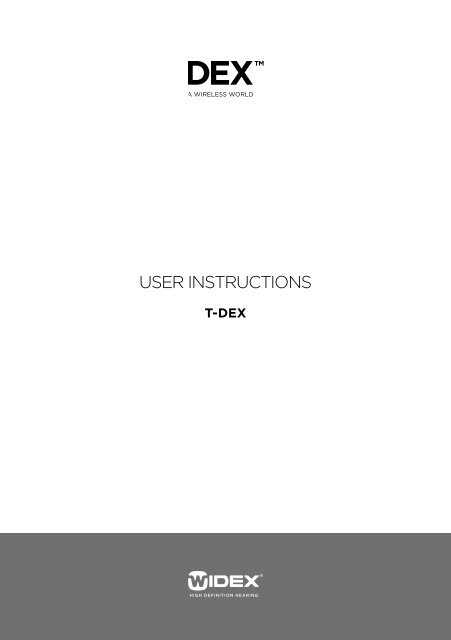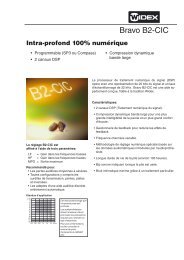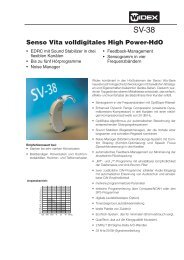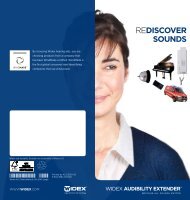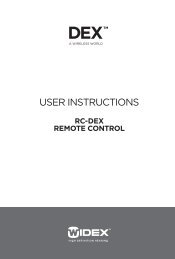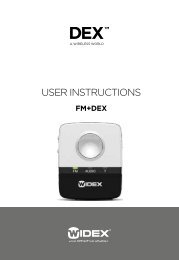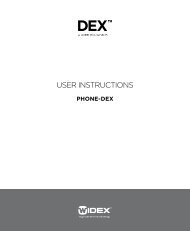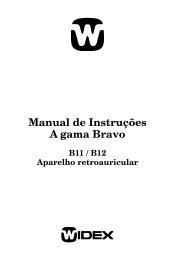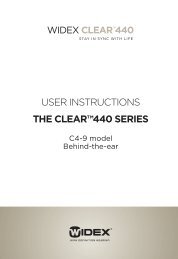Users instructions T-DEX
Users instructions T-DEX
Users instructions T-DEX
Create successful ePaper yourself
Turn your PDF publications into a flip-book with our unique Google optimized e-Paper software.
User <strong>instructions</strong><br />
T-Dex
Table of contents<br />
Package content 2<br />
Functions 3<br />
Setup 4<br />
Wireless setup for mobile telephone 4<br />
Installing neck loop 4<br />
Operation 5<br />
Indicators 5<br />
Charging 5<br />
Adjusting volume 5<br />
Accepting an incoming call 6<br />
Making a mobile telephone call 6<br />
Rejecting an incoming call 6<br />
Warranty 7<br />
Test and approval 8<br />
Warnings 9<br />
FCC 11<br />
Package content<br />
T-<strong>DEX</strong><br />
Power supply<br />
Congratulations and thank you for purchasing T-<strong>DEX</strong>.<br />
T-<strong>DEX</strong> is a hands-free, neck-loop solution for amplifying sound from your Bluetooth mobile phone. T-<strong>DEX</strong> has<br />
been specially designed for people with impaired hearing who want to use a mobile phone hands-free – and<br />
without any compromise in sound quality.<br />
2
Functions<br />
R9<br />
R1: On/off switch, answering button, and Bluetooth<br />
indicator<br />
R2: Volume button +/- (up/down)<br />
R3: Bluetooth and volume level 1 indicator<br />
R4: Volume level 2 indicator<br />
R7<br />
R5<br />
R8<br />
R5: Battery and volume level 3 indicator<br />
R6: Volume level 4 indicator<br />
R2<br />
R1<br />
R7: Volume level 5 indicator<br />
R8: Headphones jack<br />
R9: Neck loop jack<br />
R10<br />
R3<br />
R6<br />
R4<br />
R10: Neck loop<br />
R11: Charging jack<br />
R11<br />
Button/diode/jack<br />
R1<br />
R2+ (up)<br />
R2- (down)<br />
Functions<br />
Power on (hold for up to 5 seconds)<br />
Power off (hold for up to 5 seconds)<br />
Answering and ending mobile telephone calls<br />
Blue light: Bluetooth active<br />
Blue blink: Incoming call<br />
Volume up<br />
Volume down<br />
Reject mobile telephone call (hold for 2 seconds)<br />
R3<br />
Blue blink: Bluetooth not connected<br />
Green light: Volume level 1<br />
R4 Green light: Volume level 2<br />
R5 When in use<br />
• Red blink: Low battery<br />
• Green light: Volume level 3<br />
When charging<br />
• Red light: Charging<br />
• Green light: Fully charged<br />
R6 Green light: Volume level 4<br />
R7 Green light: Volume level 5<br />
R8<br />
R9<br />
R10<br />
R11<br />
Jack for headphones<br />
Jack for neck loop<br />
Neck loop<br />
Jack for charger<br />
3
Setup<br />
Wireless setup for mobile telephone<br />
Establishing a wireless connection between the Bluetooth mobile telephone and the T-<strong>DEX</strong><br />
1. Turn T-<strong>DEX</strong> on by holding down the receiver button R1 for up to five seconds.<br />
2. Enter the mobile telephone menu to allow the mobile telephone to search for available Bluetooth devices.<br />
3. Select the Bluetooth entry “T-<strong>DEX</strong>”.<br />
4. Enter the pass code into the mobile telephone (0000). Select connect. A short beep will be heard in the<br />
hearing aid or in the headphones.<br />
5. Once the wireless connection is established, receiver indicator R3 stops blinking blue.<br />
2<br />
3<br />
T-<strong>DEX</strong><br />
R3<br />
5<br />
Please note:<br />
• Once a wireless connection between T-<strong>DEX</strong> and a<br />
Bluetooth unit has been established the units will<br />
automatically connect when they are within range of<br />
each other.<br />
• During telephone conversations, the receiver indicator R1<br />
will illuminate blue indicating that the wireless connection<br />
is active.<br />
Installing neck loop<br />
Neck loop and T/MT function on HA<br />
In order to use T-<strong>DEX</strong> with hearing aids in T-position (telecoil), the hearing aid must be equipped with a telecoil<br />
fitted by the hearing care professionel.<br />
Installing neck loop<br />
1. Detach neck loop R10 from receiver jack R9 by pulling the loop wire.<br />
2. Place the T-<strong>DEX</strong> on the chest and place loop wire around the neck.<br />
3. Reattach neck loop R10 to receiver jack R9.<br />
4. Switch hearing aid to T (telecoil only) or MT (microphone and telecoil simultaneously) position.<br />
R9<br />
R10<br />
R9<br />
Please note:<br />
• Connecting headphones<br />
to the headphones jack R8<br />
disconnects the signal to<br />
the neck loop.<br />
1<br />
2 3<br />
4
Operation<br />
Indicators<br />
Below you can see an overview of the light indicators on T-<strong>DEX</strong><br />
Flashing blue (R1):<br />
Blue (R1):<br />
Flashing blue (R3):<br />
Green (R3-R7):<br />
Flashing red (R5):<br />
Incoming call<br />
Wireless Bluetooth call activated<br />
No Bluetooth connection<br />
Volume level<br />
Battery low<br />
Charging<br />
If the T-<strong>DEX</strong> light indicator R5 flashes red during operation, or if the unit cannot be turned on, T-<strong>DEX</strong><br />
requires recharging.<br />
1. Connect the power supply wire to T-<strong>DEX</strong>’s jack R11.<br />
2. Connect the power supply to a power source and turn on.<br />
3. The light indicator R5 lights continuously red during recharging.<br />
4. When T-<strong>DEX</strong> is fully recharged, light indicator R5 lights continuously green.<br />
* Plugs vary from country to country.<br />
*<br />
R11<br />
1 2<br />
3<br />
- +<br />
4 Charged<br />
Please note:<br />
• We recommend fully charging<br />
batteries before use, however,<br />
partly charging the units does<br />
not inflict damage to them.<br />
Adjusting volume<br />
1. Press receiver button R2+ (volume up) or R2- (volume down) to set comfortable listening level.<br />
2. The receiver indicators R3 to R7 illuminate depending on volume level.<br />
R2+<br />
R2-<br />
1<br />
2<br />
Please note:<br />
• The maximum volume level has been reached if all five indicators R3 to R7 are illuminated. If the signal is still too<br />
weak, adjust the volume on your mobile telephone or contact your hearing care professionel for adjustment of the<br />
telecoil in the hearing aid.<br />
5
Operation<br />
Accepting an incoming call<br />
1. When a call comes in, a ringing tone will be heard in the hearing aid or headphones and the receiver<br />
indicator R1 starts blinking blue.<br />
2. Press the button R1 to accept the call.<br />
3. Press the button R1 to end the call.<br />
1 2<br />
3<br />
R1 R1 R1<br />
Please note:<br />
• Only make a single short push to accept or end a call. It may take a couple of seconds before a call is<br />
completely connected or disconnected.<br />
• The ringing tone of the mobile telephone call may be the same sound as heard from the mobile telephone<br />
itself depending on the mobile telephone used.<br />
• If T-<strong>DEX</strong> is turned off when a mobile telephone call comes in, that specific call cannot be answered or ended<br />
using T-<strong>DEX</strong>.<br />
Making a mobile telephone call<br />
1. Turn on T-<strong>DEX</strong> by pressing the button R1 for up to five seconds.<br />
2. Enter the dial number on the mobile telephone and pick up the handset.<br />
3. The call is automatically transferred to T-<strong>DEX</strong>.<br />
4. To end the call, press the button R1 or end the call on the mobile telephone.<br />
Rejecting an incoming call<br />
1. When a call comes in, a ringing tone will be heard in the hearing aid or headphones and the receiver<br />
indicator R1 starts blinking blue.<br />
2. Press receiver button R2- (volume down) for 2 seconds to reject the call.<br />
R2-<br />
1<br />
R1<br />
2<br />
6
Warranty<br />
What is covered by this warranty<br />
Any electronic component which, because of workmanship, manufacturing, or design defects, fails to function<br />
properly under normal use during the lifetime of this warranty will be replaced or repaired at no charge for parts<br />
or labour when returned to the factory service centre. Transportation cost are to be met by the customer. If it<br />
is determined that repair is not feasible, the entire unit may be replaced with an equivalent unit upon mutual<br />
agreement of the manufacturer and customer.<br />
What is not covered by this warranty:<br />
1 Malfunctions resulting from abuse, neglect or accident.<br />
2 Peripheral accessories as itemized within the product brochure, when such items are returned after 90<br />
days from the original purchase.<br />
3 Batteries.<br />
4 Instruments connected, installed, used or adjusted in a manner contrary to <strong>instructions</strong> provided by the<br />
manufacturer.<br />
5 Consequential damages and damages resulting from delay or loss of this instrument. The exclusive<br />
remedy under this warranty is strictly limited to repair or replacement as herein provided.<br />
6 Products damaged in transit unless investigated by the shipper and returned to the warrantor with the<br />
investigation report.<br />
Widex A/S reserves the right to make changes to the design or construction of any of its instruments at any time<br />
without incurring any obligation to make any changes whatsoever on units previously purchased. This warranty is<br />
in lieu of all other expressed warranties. All expressed and implied warranties will terminate upon the expiration of<br />
this written warranty. No representative or person is authorised to represent or assume for us any liability in connection<br />
with the sale or use of our products other than as set forth above. The above warranty does not affect<br />
any legal rights that you might have under applicable national legislation governing the sale of<br />
consumer goods. Your distributor may have issued a warranty that goes beyond the clauses of this limited warranty.<br />
Please consult your distributor for further information.<br />
What to do if you need service<br />
If you require service under the terms of this warranty, carefully package the instrument to prevent damage and return<br />
it to your distributor (see information on back cover). Please provide your receipt, a detailed description of the<br />
problem, your full name, billing address and telephone number.<br />
7
Test and approval<br />
Phonic Ear A/S, Kongebakken 9, 2765 Smørum, Denmark<br />
CAUTION<br />
! !<br />
Danger of explosion if the battery is<br />
incorrectly replaced.<br />
Replace only with the same or equivalent type.<br />
Hereby, Phonic Ear A/S declares that this T-<strong>DEX</strong> is in compliance with the essential requirements and other relevant<br />
provisions of Directive 1999/5/EC.<br />
A copy of the Declaration of Conformity can be found at http://www.phonicear.dk/T-<strong>DEX</strong><br />
Electrical and electronic equipment (EEE) contains materials, components and substances that could be<br />
dangerous or detrimental to human health and the environment if waste electrical and electronic equipment (WEEE) is<br />
not disposed of correctly.<br />
Products marked with the crossed-out rubbish bin shown above are electrical and electronic equipment. The crossed-out<br />
dustbin indicates that waste electrical and electronic equipment may not be disposed of with unsorted household waste<br />
and that it must be collected separately.<br />
In developing and manufacturing your Widex product, we used high-quality materials and components that can be<br />
reused. Thus, when disposing of your waste electrical and electronic equipment, you must use a<br />
collection system designated for this purpose, regardless of whether you dispose of your waste at your local civic amenity<br />
site or whether your waste is collected from your household. Please contact your local authority for further information.<br />
Batteries contain substances that can be harmful to human health and the environment if not handled correctly.<br />
Batteries are marked with the crossed-out rubbish bin symbol illustrated. This symbolises that exhausted batteries must<br />
not be disposed of together with unsorted household rubbish, but are to be collected separately.<br />
Some batteries are also marked with the chemical symbol Hg (mercury), Cd (cadmium) or Pb (lead). These substances<br />
are particularly harmful, so it is important that they are collected and disposed of via an established recycling scheme.<br />
This ensures that your batteries are reused in compliance with regulations and do not damage the environment.<br />
Therefore, when disposing of exhausted batteries, make sure that you utilise an established recycling scheme. This might<br />
involve delivering them to a designated collection point or recycling centre, or they may be collected directly from your<br />
address. For further details, please contact your local authorities.<br />
How to remove batteries<br />
1. Unscrew two screws in the top corners on the rear of unit<br />
2. Open top cover by lifting cover up in the top<br />
3. Remove top cover completely<br />
4. Cut battery away from the printed circuit board<br />
5. Cut wires one at a time<br />
The socket outlet must be installed near to the equipment and must be easily accessible. Only use power supplies listed<br />
in the user guide.<br />
The following switch mode power supply can be used with the T-<strong>DEX</strong>. Manufacture: Fuhua, MODEL No.: UE08WCP-<br />
060100SPA, Input: 100-240V AC 400mA 50-60Hz, Output: 6V DC 1.0A<br />
8
Warnings<br />
You should familiarize yourself fully with the following general warnings and the entire contents of this booklet before<br />
using your T-<strong>DEX</strong>.<br />
Misuse can result in sudden and permanent hearing loss.<br />
T-<strong>DEX</strong> is not a toy and therefore should be kept out of the reach of children and anyone else e.g. people with learning<br />
difficulties who might swallow parts or otherwise cause injury to themselves. Special attention should be paid to the<br />
smaller components in order to prevent children from swallowing them and choking. If a part is swallowed, see a doctor<br />
immediately.<br />
Always make sure to set the volume controls correctly according to your hearing. By using T-<strong>DEX</strong> with a sound pressure<br />
level that is too high, you may risk impairing your hearing.<br />
Never allow others to wear or use your T-<strong>DEX</strong> as incorrect/wrongful usage could cause permanent damage to their hearing.<br />
Dysfunction in T-<strong>DEX</strong><br />
T-<strong>DEX</strong> may stop functioning, for instance if the batteries are discharged. You should be aware of this possibility, in particular<br />
when you are in traffic or otherwise dependent on warning sounds.<br />
Interference<br />
Your T-<strong>DEX</strong> has been thoroughly tested for interference according to the most stringent international standards. But new<br />
technical developments constantly bring new products into society, and some may emit electromagnetic radiation, leading<br />
to unforeseen interference in T-<strong>DEX</strong>. Examples include induction cooking appliances, shop alarm systems, mobile<br />
telephones, fax machines, personal computer devices, X-rays, computer tomography etc.<br />
T-<strong>DEX</strong> is designed to comply with the most stringent Standards of International Electromagnetic Compatibility. However,<br />
T-<strong>DEX</strong> might cause interference with other medical devices. Such interference can also be caused by radio signals, power<br />
line disturbances, airport metal detectors, electromagnetic fields from other medical devices and electrostatic discharges.<br />
Possible side effects<br />
The otherwise non-allergenic materials used in T-<strong>DEX</strong> may in rare cases cause a skin irritation. Consult a doctor if you<br />
experience any side effects.<br />
Use on Aircrafts<br />
The T-<strong>DEX</strong> should not be used on board on aircrafts unless specifically permitted by the flight personnel.<br />
Implantable devices<br />
T-<strong>DEX</strong> is designed to comply with the most stringent Standards of International Electromagnetic Compatibility. However,<br />
T-<strong>DEX</strong> might cause interference with other medical devices such as defibrillators and pacemakers. Please, contact the<br />
manufacturer of your implantable device for information about the risk of disturbance. Interference can also be caused<br />
by power line disturbances, airport metal detectors, electromagnetic fields from other medical devices, radio signals and<br />
electrostatic discharges.<br />
Never exposure T-<strong>DEX</strong> to great heat by putting it in the oven, in the micro wave oven or by burning it. There is a risk that<br />
it will explode and cause serious injury.<br />
The safety of the use of T-<strong>DEX</strong> with auxillary input cable is determined by external signal source. When the input cable<br />
is connected to mains-operated equipment, this equipment must comply with IEC-60065, IEC-60601, IEC-60950 or<br />
equivalent safety standards.<br />
9
The emission power from the T-<strong>DEX</strong> is below international emission limits for Human Exposure. For comparison, the<br />
radiation of the T-<strong>DEX</strong> is equal to that of a Bluetooth headset for a mobile telephone. T-<strong>DEX</strong> complies with international<br />
standards concerning electromagnetic Compatibility.<br />
Cleaning and maintenance<br />
Any dirt, moisture or grease should be cleaned of by using a dry or damp cloth. T-<strong>DEX</strong> must never be washed or immersed<br />
in water or other liquids. Make sure not to drop T-<strong>DEX</strong> onto hard surfaces.<br />
Avoid heat, humidity and chemicals<br />
Your T-<strong>DEX</strong> must never be exposed to extreme heat e.g. left inside a parked car in the sun. It must never be exposed to a<br />
lot of moisture e.g. steam baths, showers or heavy rain. Nor must it be dried in micro wave ovens or other ovens. T-<strong>DEX</strong><br />
must not be exposed to or cleaned with cleaning chemicals or alcohols.<br />
Use in cars<br />
Using the T-<strong>DEX</strong> with a mobile phone while driving can distract you. If driving conditions demand it, pull of the road and<br />
park before making and answering calls.<br />
Use of the neck loop<br />
If by accident the neck strap should get caught in something while wearing it, the neck loop is constructed to open<br />
automatically. Therefore, never try to modify the neck loop in an unauthorized way. The neck loop should not be used for<br />
children who weighs less than 11 kg.<br />
10
FCC<br />
FCC & IC RF Radiation Exposure Statement:<br />
This equipment complies with FCC radiation exposure limits set forth for an uncontrolled environment. End users must<br />
follow the specific operation <strong>instructions</strong> for satisfying RF exposure compliance. This transmitter must not be co-located or<br />
operating in conjunction with any other antenna or transmitter.<br />
This device complies with Part 15 of the FCC & IC rules and RSS-210 of Industry Canada.<br />
Operation is subject to the following two conditions:<br />
• This device may not cause harmful interference<br />
• This device must accept any interference received, including interference that may cause undesired operation<br />
Changes or modifications not expressly approved by Widex could void the user’s authority to operate the equipment.<br />
NOTE:<br />
This equipment has been tested and found to comply with the limits for a Class B digital device, pursuant to Part 15 of<br />
the FCC Rules. These limits are designed to provide reasonable protection against harmful interference in a residential<br />
installation. This equipment generates, uses and can radiate radio frequency energy and, if not installed and used in accordance<br />
with the <strong>instructions</strong>, may cause harmful interference to radio communications. However, there is no guarantee<br />
that interference will not occur in a particular installation. If this equipment does cause harmful interference to radio or<br />
television reception, which can be determined by turning the equipment off and on, the user is encouraged to try to correct<br />
the interference by one or more of the following measures:<br />
• Reorient or relocate the receiving antenna.<br />
• Increase the separation between the equipment and receiver.<br />
• Connect the equipment into an outlet on a circuit different from<br />
that to which the receiver is connected.<br />
• Consult the dealer or an experienced radio/TV technician for help.<br />
11
¡9 514 0200 001,¤ ¡#01v¤<br />
Printed by HTO / 2012-07<br />
9 514 0204 001 #02


